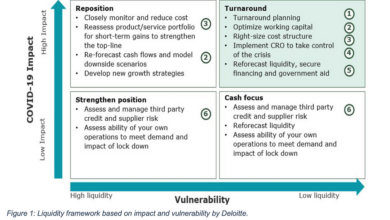
Cash Flow Management During Uncertain Economy A Guide
Cash flow management during uncertain economy is crucial for businesses and individuals alike. Navigating economic volatility requires proactive strategies to maintain financial stability. This guide explores key factors influencing cash flow, effective management strategies, and the importance of financial planning and risk assessment.
Economic uncertainty, characterized by factors like geopolitical instability, inflation, and supply chain disruptions, significantly impacts cash flow. Understanding these elements is paramount for developing robust financial plans.
Understanding Economic Uncertainty

Navigating a volatile economic landscape requires a deep understanding of the forces driving uncertainty. Economic uncertainty, characterized by unpredictability and a wide range of potential outcomes, poses significant challenges for businesses and consumers alike. This uncertainty necessitates proactive strategies for cash flow management, ensuring resilience in the face of fluctuating market conditions.Economic uncertainty isn’t a new phenomenon; history is replete with periods of significant market volatility.
However, the nature and complexity of modern economies, with interconnected global markets and rapid technological advancements, often exacerbate these fluctuations. Successfully managing cash flow during periods of uncertainty demands a thorough understanding of the underlying factors driving these changes.
Defining Economic Uncertainty
Economic uncertainty is a state of unpredictability regarding future economic conditions. It’s characterized by a lack of clarity regarding key economic variables like inflation, interest rates, and GDP growth. This lack of clarity makes it difficult to forecast future outcomes and plan accordingly. Uncertainty is not simply the absence of knowledge, but also the presence of competing, plausible scenarios.
This inherent ambiguity makes it challenging to confidently predict the future path of the economy.
Factors Contributing to Economic Uncertainty
Several factors contribute to the pervasive nature of economic uncertainty. These include geopolitical events, inflationary pressures, and supply chain disruptions. Understanding these drivers is critical for businesses to adapt and mitigate potential risks to their cash flow.
Geopolitical Events
Geopolitical instability, such as international conflicts, trade wars, and political tensions, can significantly impact economic stability. These events often lead to increased volatility in global markets, impacting trade flows, investment decisions, and consumer confidence. The war in Ukraine, for example, dramatically disrupted global energy markets and supply chains, creating substantial uncertainty.
Inflation
Inflation, characterized by a sustained increase in the general price level of goods and services, can erode purchasing power and impact consumer spending habits. High inflation can also lead to increased borrowing costs, affecting businesses’ profitability and cash flow. The persistent inflation experienced in many economies in recent years is a major source of uncertainty, particularly for businesses relying on fixed-price contracts.
Supply Chain Disruptions
Global supply chains are complex and interconnected, making them vulnerable to disruptions. Events like natural disasters, pandemics, or geopolitical tensions can easily disrupt these chains, leading to shortages of materials, delays in production, and increased costs. The COVID-19 pandemic, for example, highlighted the vulnerability of global supply chains and the cascading effects of disruptions on businesses worldwide.
Impact on Businesses and Consumers
| Factor | Description | Potential Impact on Cash Flow |
|---|---|---|
| Geopolitical Events | International conflicts, trade wars, political tensions | Disrupted trade, decreased demand, increased costs |
| Inflation | Sustained increase in the general price level | Reduced purchasing power, increased borrowing costs, decreased profitability |
| Supply Chain Disruptions | Disruptions in global supply chains | Increased costs, production delays, shortages of materials |
These factors can directly impact both businesses and consumers. Businesses face challenges in forecasting demand, managing costs, and securing necessary resources. Consumers experience reduced purchasing power and increased uncertainty regarding their financial future. The interplay of these factors creates a complex environment, necessitating careful cash flow management strategies.
Strategies for Cash Flow Management
Navigating economic uncertainty requires proactive cash flow management. A robust strategy is crucial for businesses to weather storms and maintain stability. This involves understanding not only your current financial position but also anticipating potential future challenges. Effective cash flow management during uncertain times isn’t just about reacting to events; it’s about anticipating and proactively preparing for them.Effective cash flow management during economic uncertainty is about more than just reacting to events.
It’s about understanding your current financial position, anticipating future challenges, and proactively preparing for them. This proactive approach is critical for maintaining stability and mitigating the impact of economic fluctuations.
Improving Cash Inflows, Cash flow management during uncertain economy
Predicting and managing cash inflows is vital during economic uncertainty. Explore new revenue streams to diversify your income and reduce dependence on existing sources. This might involve developing new products or services, entering new markets, or implementing targeted marketing campaigns. Pricing strategies also play a significant role. Consider adjusting prices to reflect market conditions while maintaining profitability.
Analyzing competitor pricing and market demand is essential to optimize your pricing strategy.
Optimizing Pricing Strategies
Dynamic pricing, based on real-time demand and market conditions, can significantly enhance cash inflows. Implementing a tiered pricing system, offering bundles, or introducing seasonal discounts are examples of strategies that can increase sales and revenue. This is particularly important during periods of economic uncertainty, when consumers may be more price-sensitive.
Managing Cash Outflows
Cash outflows are equally important to manage during uncertain economic times. Negotiating payment terms with vendors can provide crucial breathing room. Discuss extended payment options or early payment discounts with suppliers to optimize cash flow. Prioritize expenses and identify non-essential spending. Cutting back on discretionary expenses, like marketing campaigns or travel, can free up cash for critical operations.
Reviewing contracts and renegotiating terms with vendors can lead to significant cost savings and improve cash flow.
Prioritizing Expenses
Analyzing and prioritizing expenses is crucial for managing cash flow. Identifying non-essential expenditures allows for a focus on core operational costs. Categorize expenses based on their importance to the business. This analysis can help determine which expenses can be reduced or eliminated temporarily without compromising essential operations.
Table of Strategies for Cash Flow Management
| Strategy | Benefits | Implementation Steps |
|---|---|---|
| Explore new revenue streams | Diversifies income, reduces reliance on existing sources | Identify new product/service opportunities, research target markets, develop marketing strategies |
| Optimize pricing strategies | Increases sales and revenue, adjusts to market conditions | Analyze competitor pricing, understand market demand, implement dynamic pricing models |
| Negotiate payment terms | Provides breathing room, improves cash flow | Contact vendors, discuss extended payment options, explore early payment discounts |
| Prioritize expenses | Free up cash for core operations, identifies non-essential spending | Categorize expenses, identify non-essential areas, implement cost-cutting measures |
Importance of Budgeting and Forecasting
Navigating an uncertain economic landscape requires proactive financial planning. Budgeting and forecasting are essential tools for anticipating potential cash flow fluctuations and adjusting strategies accordingly. By understanding future financial needs and potential challenges, businesses can make informed decisions to maintain stability and growth. A well-defined budget and forecast provide a roadmap for managing resources and achieving financial objectives during economic uncertainty.Economic unpredictability necessitates a dynamic approach to financial planning.
A static budget, unable to adapt to changing market conditions, can quickly become outdated and ineffective. Robust budgeting and forecasting processes are vital to anticipate and respond to these changes, allowing businesses to adjust their strategies in real-time. This adaptability is crucial for survival and success in turbulent economic times.
Creating Realistic Budgets and Forecasts
Accurate budgeting and forecasting are crucial for effective cash flow management. Realistic projections are built on careful analysis of historical data, current market trends, and potential future scenarios. To achieve this, businesses should meticulously track and analyze their financial performance, noting patterns and identifying potential risks and opportunities. This detailed analysis should form the foundation of any budget or forecast.
Methods for Budget and Forecast Development
Developing realistic budgets and forecasts in uncertain economic times requires incorporating multiple perspectives. A combination of top-down and bottom-up approaches often proves most effective. Top-down planning sets overarching targets, while bottom-up input from various departments provides crucial details and insights into specific operational needs. This combined approach allows for more comprehensive and nuanced projections.
- Historical Data Analysis: Examining past financial performance is fundamental. Trends in revenue, expenses, and cash flow provide valuable insights into potential future outcomes. By identifying patterns and seasonal variations, businesses can create more accurate predictions. For example, a retail store might see a surge in sales during the holiday season; incorporating this historical data into the forecast allows for proactive cash flow management during this period.
- Market Research and Economic Indicators: Staying informed about economic indicators and market trends is vital. Monitoring interest rates, inflation, unemployment rates, and consumer confidence can offer valuable clues about future financial conditions. For example, rising interest rates might signal a need for adjusting borrowing strategies or pricing models.
- Scenario Planning: Considering various possible future scenarios, both optimistic and pessimistic, is crucial. This process helps businesses prepare for a range of outcomes. For example, a manufacturing company might create scenarios based on varying raw material costs or changes in consumer demand. This contingency planning enhances resilience during uncertain times.
Incorporating Economic Indicators and Market Trends
Financial plans should incorporate relevant economic indicators and market trends. This involves researching and understanding factors that influence the market, such as interest rates, inflation, and consumer sentiment. These external factors often significantly impact a company’s financial performance. For instance, a sudden increase in interest rates could necessitate adjustments to loan repayment schedules and potentially affect investment decisions.
Similarly, changes in consumer confidence might influence sales projections.
Regular Review and Adjustment of the Budget
Regular reviews and adjustments are essential for maintaining the relevance and effectiveness of the budget and forecast. This involves monitoring actual performance against projected figures, identifying any significant variances, and adapting the budget accordingly. Flexibility and responsiveness to changing conditions are critical. By regularly reviewing and adjusting the budget, businesses can ensure they remain on track, make informed decisions, and adapt to unforeseen economic shifts.
A key aspect of this process is to establish clear reporting and communication channels for timely feedback and analysis. A company should create a system for tracking actual results, comparing them to the budget, and identifying any discrepancies.
Importance of Inventory Management
Managing inventory effectively is crucial for maintaining healthy cash flow, especially during economic uncertainty. Holding too much inventory ties up capital that could be used for other investments or operational needs. Conversely, running low on inventory can lead to lost sales and dissatisfied customers, impacting revenue and future opportunities. A well-tuned inventory management system can act as a buffer, mitigating the effects of market fluctuations and ensuring your business remains resilient.
Inventory Management and Cash Flow
Inventory management directly impacts cash flow. High inventory levels mean more capital tied up in unsold goods. This reduces the amount of money available for other business activities, potentially hindering growth and profitability. Conversely, insufficient inventory can lead to lost sales and reduced revenue. A carefully crafted inventory management strategy can minimize these risks and optimize cash flow.
Discover more by delving into cima ethics confidentiality rules further.
Risks of Excessive Inventory
Holding excessive inventory presents several significant risks during economic uncertainty. Firstly, it ties up significant capital, reducing liquidity and potentially impacting a company’s ability to meet short-term obligations. Secondly, holding obsolete or slow-moving inventory can result in losses due to deterioration, damage, or obsolescence. Thirdly, increased storage costs, including warehousing, insurance, and security, can substantially eat into profits.
Finally, the risk of market fluctuations affecting demand and reducing the value of the inventory increases as the inventory level grows.
Strategies for Optimizing Inventory Levels
Implementing strategies to optimize inventory levels is vital for maintaining healthy cash flow. One such strategy is just-in-time (JIT) inventory management. This approach focuses on procuring and producing goods only when needed, minimizing the holding costs and risks associated with excessive inventory. Other strategies include:
- Demand Forecasting: Accurately predicting future demand is critical for determining optimal inventory levels. This involves analyzing historical sales data, market trends, and external factors to develop realistic forecasts. Using sophisticated forecasting tools can improve the accuracy of predictions and minimize the risk of overstocking or understocking.
- Inventory Turnover Rate Analysis: Monitoring the inventory turnover rate provides insights into the efficiency of inventory management. A higher turnover rate indicates that inventory is being sold quickly, which is generally a positive sign. Analyzing the turnover rate for different product categories can help identify areas for improvement and adjust inventory levels accordingly.
- Supplier Relationships: Building strong relationships with reliable suppliers can ensure timely delivery of goods, reducing the need for excessive buffer stock. Negotiating favorable terms and agreements with suppliers can further optimize inventory management and improve cash flow.
Impact of Different Inventory Management Approaches on Cash Flow
| Inventory Management Approach | Impact on Cash Flow | Explanation |
|---|---|---|
| Just-in-Time (JIT) | Improved Cash Flow | Minimizes inventory holding costs and capital tied up in inventory. |
| High Inventory Levels | Reduced Cash Flow | Significant capital tied up in unsold goods, increasing storage costs and risk of obsolescence. |
| Low Inventory Levels | Potentially Reduced Cash Flow | Increased risk of stockouts, lost sales, and dissatisfied customers. |
Credit Management and Risk Mitigation: Cash Flow Management During Uncertain Economy
Navigating an uncertain economy demands meticulous attention to credit management. Effective credit policies and risk assessment strategies are crucial for minimizing potential losses and ensuring business stability. Proper credit management not only protects your bottom line but also allows for more confident investment and expansion during periods of economic volatility. Understanding the nuances of credit risk is paramount in today’s environment.Credit risk, the possibility of a borrower defaulting on a loan or failing to meet contractual obligations, is an ever-present concern, especially during economic downturns.
A robust credit management system acts as a safety net, mitigating the impact of such events.
Strategies for Managing Credit Risk in a Fluctuating Economy
A proactive approach to credit risk management involves implementing strategies that anticipate and address potential issues. These strategies must adapt to the evolving economic landscape, shifting market conditions, and the specific needs of your business. Developing tailored credit policies, coupled with continuous monitoring and adjustment, is key to success.
- Diversification of Credit Portfolio: Reducing reliance on a single customer or industry helps spread risk. By diversifying your customer base, you lessen the impact of any single customer’s financial difficulties on your overall cash flow. For instance, a retail company might diversify its customer base by targeting different demographics or offering a wider range of products.
- Thorough Credit Application Evaluation: A meticulous credit application review process is essential. Scrutinize financial statements, credit history, and industry trends to assess the borrower’s ability to repay. Use existing credit scoring systems and develop internal risk assessment tools for accurate evaluation. Inaccurate assessment of creditworthiness can lead to substantial financial losses.
- Implementing Stricter Credit Policies: Adjusting credit terms, such as longer payment cycles or higher interest rates, can help to offset risk. Implementing stricter credit policies might mean demanding higher security or collateral. This can be particularly important when dealing with borrowers who exhibit increased risk profiles. Reviewing and adjusting credit policies based on current market conditions is critical.
- Continuous Monitoring of Borrower Performance: Establish a system for ongoing monitoring of borrower performance. Regularly review their financial health and adherence to agreed-upon terms. Proactive monitoring allows for early identification of potential issues, allowing you to intervene and mitigate potential losses. Monitoring should include factors like industry performance, changes in the borrower’s financial statements, and general economic conditions.
Importance of Credit Scoring and Risk Assessment
Accurate credit scoring and risk assessment are cornerstones of effective credit management. These tools provide objective criteria for evaluating borrower creditworthiness, enabling more informed lending decisions.
- Data-Driven Credit Scoring: Employing data-driven credit scoring models allows for a standardized and consistent evaluation of creditworthiness. A strong scoring system, based on a wide range of factors, can predict the likelihood of default. Accurate scoring can reduce the chances of approving loans to high-risk borrowers.
- Risk Assessment Models: Develop risk assessment models that incorporate various factors, including financial health, industry trends, and economic conditions. These models should be continuously refined and updated to reflect the current economic environment. This approach to credit risk assessment allows you to develop more precise estimations of potential financial losses.
- Regular Model Validation: Periodically validate and update your risk assessment models. The economic landscape is dynamic, and models that were effective in the past may need adjustments to remain accurate. Staying abreast of industry best practices and current economic trends is key to the model’s effectiveness. This ensures that the model continues to reflect current economic conditions.
Implementing Effective Credit Policies to Minimize Potential Losses
Clear and well-defined credit policies are crucial for maintaining financial stability. These policies should clearly Artikel the conditions for extending credit, the terms of repayment, and the procedures for handling potential defaults.
- Clear Credit Terms and Conditions: Establish clear, concise, and easily understood credit terms and conditions. Include details on repayment schedules, interest rates, late payment penalties, and security requirements. Transparency in credit terms and conditions can prevent future disputes.
- Risk Mitigation Procedures: Develop specific procedures for handling potential defaults. This includes establishing a process for collection efforts, legal recourse, and potential write-offs. Having these procedures in place can help minimize losses from delinquent accounts.
- Regular Policy Review and Updates: Regularly review and update your credit policies to reflect changing economic conditions, industry standards, and company needs. Adapting to economic changes is crucial to ensure the policies remain effective.
Benefits of Alternative Financing Options During Economic Downturns
During economic downturns, traditional financing options may become limited or more expensive. Alternative financing methods can offer viable solutions.
- Crowdfunding Platforms: Crowdfunding can provide access to capital from a large pool of investors, particularly for startups and small businesses. This method can be advantageous for firms seeking capital during periods of economic uncertainty.
- Invoice Financing: Invoice financing allows businesses to access funds by selling their outstanding invoices to a financing company. This can be a valuable source of liquidity when traditional financing is unavailable.
- Peer-to-Peer Lending: Peer-to-peer lending platforms connect borrowers directly with investors, offering alternative financing options. This approach can offer flexible terms and lower interest rates compared to traditional lenders.
Financial Planning and Risk Assessment

Navigating an uncertain economy requires a proactive approach to financial planning. A robust plan, factoring in potential risks, is crucial for maintaining stability and ensuring the long-term viability of your business. This involves more than just projecting revenue; it necessitates a thorough understanding of your financial resilience and the ability to adapt to unforeseen circumstances.
Developing a Robust Financial Plan
A robust financial plan should be dynamic, not static. It must anticipate potential challenges, such as fluctuating interest rates, supply chain disruptions, or changes in consumer demand. This plan should include detailed projections for revenue, expenses, and cash flow, considering various scenarios for economic conditions. Regular reviews and adjustments are essential to maintain alignment with the evolving economic landscape.
Assessing Financial Resilience
Assessing financial resilience involves evaluating the ability of your business to withstand economic shocks. Key metrics to consider include: current ratio, quick ratio, debt-to-equity ratio, and operating cash flow. These metrics, when analyzed together, provide a comprehensive view of your company’s financial health and its capacity to weather economic storms. A thorough understanding of these metrics will help determine the level of financial cushion your business possesses.
For example, a company with a high current ratio is better positioned to meet short-term obligations than one with a low ratio.
Identifying Potential Vulnerabilities and Developing Contingency Plans
Identifying potential vulnerabilities is an essential step in risk management. Consider external factors like economic downturns, industry-specific challenges, or regulatory changes. Internal vulnerabilities might include weaknesses in supply chain management, high levels of debt, or reliance on a single customer. Once potential vulnerabilities are identified, develop contingency plans to mitigate associated risks. These plans should Artikel specific actions to be taken if a particular risk materializes.
Enhance your insight with the methods and methods of how to clearly communicate feedback and expectations.
For example, if a significant economic downturn reduces demand, a contingency plan might involve implementing cost-cutting measures, exploring new markets, or renegotiating contracts.
Impact of Financial Decisions on Cash Flow and Business Risk
| Financial Decision | Impact on Cash Flow | Impact on Business Risk |
|---|---|---|
| Increasing Inventory Levels | Decreased cash flow (tied up capital); potentially increased risk of obsolescence. | Increased risk of financial strain if demand is low, or if inventory cannot be sold |
| Negotiating Longer Payment Terms with Suppliers | Increased cash flow (longer to pay); potentially increased risk of supplier relationship strain if not managed effectively. | Increased risk of liquidity problems if payment terms are not adhered to |
| Reducing Operating Expenses | Increased cash flow (lower expenses); potentially increased risk of service reduction or operational inefficiency. | Reduced risk of financial distress if expenses are managed efficiently. |
| Seeking Additional Funding | Increased cash flow (new capital); potentially increased risk of debt burden. | Increased risk of financial burden if interest rates rise or if debt repayment proves challenging. |
| Investing in New Technologies | Potentially decreased cash flow (initial investment); potentially reduced business risk (increased efficiency, new market opportunities). | Reduced risk of being left behind in the market, if the investment is managed effectively. |
“A robust financial plan is not just about forecasting; it’s about preparing for the unexpected.”
Expand your understanding about global cfo survey rebuild revenue streams with the sources we offer.
Adapting to Changing Market Conditions
Navigating economic uncertainty requires businesses to be agile and adaptable. Market conditions shift constantly, demanding proactive adjustments to ensure continued profitability and cash flow stability. This adaptability extends beyond simply reacting to changes; it involves anticipating trends, identifying opportunities, and strategically repositioning operations for sustained success.Responding to fluctuating market conditions requires a nuanced understanding of how these changes impact your business’s financial health.
This necessitates a constant eye on market trends, a willingness to experiment with new strategies, and a strong commitment to financial planning. By embracing these principles, businesses can navigate uncertainty and emerge stronger on the other side.
Strategies for Adapting Business Operations
Effective adaptation involves a multifaceted approach. It’s not about making drastic changes overnight, but rather about strategically adjusting operations to maintain efficiency and profitability while mitigating risks. This includes reviewing pricing models, evaluating supply chain vulnerabilities, and exploring new market segments. Implementing these adjustments requires meticulous planning and execution.
- Pricing Adjustments: Analyzing competitor pricing, assessing the impact of inflation, and adjusting pricing strategies in response to market dynamics are crucial. This might involve implementing tiered pricing models, seasonal discounts, or promotional offers to attract customers and maintain profitability.
- Supply Chain Resilience: Diversifying suppliers, establishing backup plans, and maintaining strong relationships with key vendors are essential steps. This helps mitigate disruptions caused by shortages, geopolitical events, or other external factors.
- Exploring New Market Segments: Identifying emerging market opportunities and adapting product or service offerings to meet evolving customer needs can significantly boost revenue. For example, a company that traditionally sells to retail customers could start offering wholesale options to businesses.
Identifying Emerging Opportunities
Proactively seeking and leveraging emerging opportunities is vital for maintaining cash flow during uncertain times. This requires a keen awareness of market trends and a willingness to experiment with new strategies.
- Market Research and Analysis: Conducting thorough market research helps identify potential unmet needs or emerging trends. This can be achieved through customer surveys, industry reports, and social media analysis.
- Competitive Analysis: Understanding competitors’ strategies and identifying gaps in the market can reveal opportunities for differentiation and market share gains. Analyzing their pricing, marketing, and product offerings can provide insights.
- Innovation and Product Development: Developing new products or services that address emerging needs or leverage technological advancements can open up new revenue streams and attract new customer segments. For instance, developing an online platform to improve customer service is an innovative solution.
Continuous Monitoring of Market Trends and Economic Indicators
Regular monitoring of market trends and economic indicators is crucial for proactive decision-making. This enables businesses to anticipate changes and adjust their strategies accordingly.
- Key Economic Indicators: Tracking indicators like inflation rates, interest rates, unemployment figures, and GDP growth provides insights into the overall economic climate. This information can help anticipate potential shifts in consumer behavior and adjust business strategies accordingly.
- Market Trend Analysis: Analyzing industry reports, news articles, and social media discussions can help identify emerging trends and anticipate changes in consumer demand. This allows businesses to adjust their product offerings, marketing strategies, and operations to meet evolving needs.
Tracking and Evaluating Impact of Market Changes on Cash Flow
A systematic approach to monitoring the impact of market changes on cash flow is essential.
| Indicator | Metric | Impact on Cash Flow |
|---|---|---|
| Sales Volume | Units sold, revenue | Increased or decreased sales volume directly impacts cash inflow |
| Customer Acquisition Cost | Cost per customer | High CAC can strain cash flow |
| Inventory Turnover | Inventory conversion cycle | Slow inventory turnover can lead to tied-up capital and decreased cash flow |
| Credit Collection Efficiency | Days Sales Outstanding (DSO) | Longer collection periods can decrease cash flow |
Importance of Customer Relationship Management
Navigating economic uncertainty requires a robust strategy that extends beyond financial metrics. A critical component often overlooked is the importance of strong customer relationships. Maintaining and nurturing these relationships is paramount for sustained cash flow, especially during periods of economic downturn. Customers are not just transactions; they are the lifeblood of any business. Understanding their needs and preferences is crucial for tailoring products and services to meet their evolving requirements.Customer relationships are more than just sales; they represent a network of trust and loyalty.
Cultivating this network strengthens the foundation of your business, providing a buffer against economic headwinds. This section will explore the vital role of customer relationship management (CRM) in ensuring financial stability during uncertain times.
Strategies to Retain and Acquire Customers
Effective customer retention strategies are essential for maintaining cash flow stability. Proactive engagement, personalized communication, and prompt response to customer inquiries are key elements in this process. Understanding customer pain points and actively addressing them through tailored solutions is critical. This proactive approach builds trust and strengthens the customer relationship. Acquiring new customers during economic downturns requires a targeted approach.
Highlighting the value proposition of your products or services, emphasizing affordability, and demonstrating exceptional customer service are crucial for attracting new business. A well-defined marketing strategy, targeted at specific customer segments, can significantly increase the chances of acquiring new customers.
Customer Loyalty Programs
Customer loyalty programs play a significant role in supporting cash flow stability. These programs create a system of rewards and incentives that encourage repeat purchases. Loyalty programs not only boost repeat business but also act as a feedback mechanism, allowing businesses to understand customer preferences and adjust their offerings accordingly. This understanding allows for the creation of targeted campaigns that cater to specific segments, enhancing customer satisfaction and driving consistent revenue.
By rewarding repeat customers, businesses demonstrate appreciation and foster long-term relationships, ultimately strengthening cash flow during economic downturns. A robust loyalty program can act as a safety net during economic volatility.
Customer Relationship Management Strategy
A comprehensive CRM strategy focusing on maintaining and growing revenue during economic downturns should prioritize proactive customer engagement. This includes regular communication, proactive issue resolution, and personalized offers tailored to individual customer needs. Implementing a system for collecting and analyzing customer feedback is essential for understanding shifting preferences and proactively adapting offerings to meet changing demands. Analyzing past purchasing patterns and trends can predict future customer needs, allowing businesses to adjust their inventory and pricing strategies.
This data-driven approach can significantly increase revenue while ensuring the company remains relevant and attractive to customers.Regularly reviewing and adjusting the CRM strategy is crucial for long-term success. This iterative process ensures the strategy remains effective and relevant to changing economic conditions and customer preferences. A proactive, data-driven approach to CRM is essential for weathering economic storms and ensuring sustained revenue growth.
Final Thoughts

In conclusion, managing cash flow during economic uncertainty demands a multi-faceted approach. By understanding economic factors, implementing effective strategies, and diligently monitoring financial performance, individuals and businesses can navigate challenging times with greater resilience. This comprehensive guide provides a roadmap for success in maintaining financial health amidst economic volatility.





